We ranked 3 types of EV batteries to find the most efficient and sustainable one
Amidst the booming influx of electric vehicles worldwide, automakers and tech companies have been focusing on optimizing the most vital and expensive part of EVs: the batteries.
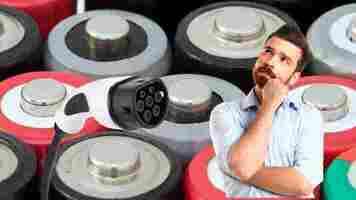
They aren’t all alike, and manufacturers use a range of different kinds of batteries. So we’ve decided to select and rank the three most prominent (or promising) battery types: lithium, solid-state , and sodium-ion batteries.
We’ll compare the batteries using four criteria: safety, energy density and charging time, sustainability, and price.
But before we begin, let’s brush up the basics we need to know.
Lithium-ion and solid-state batteries are very much alike. Both types use lithium to produce electrical energy and they have an anode (the battery’s negative terminal), a cathode (the battery’s positive terminal), and an electrolyte, which helps transfer ions from the cathode to the anode and vice versa.
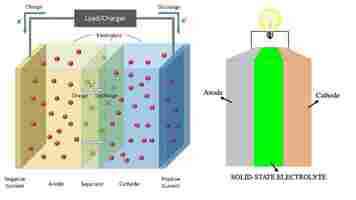

They primarily differ in the state of the electrolyte: lithium-ion batteries use liquid electrolytes and solid-state batteries use solid electrolytes.
As for sodium-ion batteries, imagine the exact same structure — the only difference is that sodium ions replace lithium ions.
And now that we’ve laid the basis, let’s rank these battery types on our selected criteria:
Lithium-ion batteries are unfortunately flammable and this has mostly to do with their liquid electrolytes, which are volatile and unstable when exposed to high temperatures.
In contrast, the solid electrolytes of solid-state batteries are more stable and significantly reduce the risk of fire.
And as for the sodium-ion batteries, they are non-flammable and don’t allow for any thermal runaway, which makes them the safest option.
Winner: Sodium-ion batteries
Sodium-ion batteries come up a bit short here. Sodium ions are larger and denser than lithium ions, which means that we need a whole more lot of the former to store and produce the equivalent energy.
On the upside, CATL’s sodium-ion battery (the best example we have so far) is expected to have an energy density of 160Wh/kg and will take 15 minutes to reach 80% of its charge. That’s actually on par with lithium-ion batteries currently on the market, ranging from 140 Wh/kg to 240Wh/kg .
But is it good enough to replace lithium batteries completely? No, it isn’t.
This energy density is still too low to compete with most of lithium-ion batteries, and we’re talking about a single product that hasn’t been tested on a large scale yet.
Solid-state batteries are the biggest competitor here. The i ncreased stability their solid electrolytes offer means that solid-state batteries can hold up to 50% more energy than their lithium-ion counterparts, while they’re expected to reach a whopping 80% charge within 12 minutes.
Winner: Solid-state batteries
Here we have the battle of the elements: lithium vs sodium.
Lithium is a relatively rare element on Earth and its increasing demand doesn’t come without an environmental impact. According to the Institute for Energy Research , lithium extraction not only consumes millions of gallons of water, but also harms the soil and causes air contamination.
In contrast, sodium is the seventh most abundant element on Earth (1,200 times more common than lithium), and can be found pretty much anywhere on Earth, including in seawater. Plus, its extraction doesn’t come with the same environmental concerns.
Winner: Sodium-ion batteries
Sodium’s abundance naturally makes it a less expensive option. It also costs less to extract and purify.
On top of that, sodium-ion cells can be made with ample metals such as iron and manganese. In contrast, lithium-ion batteries require cobalt, a metal with limited geological reserves that’s also the most expensive part of the battery, priced at approximately $28,500 per ton.
The most costly option seems to be solid-state batteries, because solid electrolytes are more expensive to produce. Specifically, solid-state batteries are projected to cost $80-90/ kWh by 2030, while the price of lithium batteries is expected to reach $60/kWh by the same time.
Winner: Sodium-ion batteries
Sodium-ion batteries!
These are followed by solid-state batteries in second place, and lithium-ion batteries in third place.
In case you’re sad about lithium’s loss, there’s no reason to be just yet. Sodium-ion and solid-state batteries are still under development and certainly have some years ahead before they can be commercialized. It’s also possible that using recycled lithium-ion batteries will turn out to be the mainstream option by that time.
Here’s why your car isn’t rolling on airless tires… yet
Wouldn’t it be great if you never had to worry about a flat tire? You could drive anywhere, roaming the globe, traveling to remote locations without a worry.

Well, stop dreaming. They exist. And they’re called airless tires. It’s a simple solution: if there’s no air in the tires, they can’t pop.
Amazing, right?
Well, you’ll need to curb your enthusiasm a little. While airless tires exist, they’re not the silver bullet we hoped for — at least for now.
First off, airless tires — also called non-pneumatic tires (NPTs) — have been around for a while.
You can find them in lawn mowers , golf carts , military vehicles , and even bicycles .
So why are we talking about them now?
Well, because tire manufacturing giants such as Goodyear and Michelin are finally developing airless tire technology for passenger cars.
Goodyear has been testing the tech on autonomous shuttles and a Tesla Model 3 , while Michelin has teamed up with GM to create its very own NPT, called “ Uptis ” (Unique Puncture-proof Tire System).
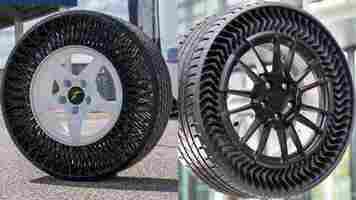

First up, there’s the obvious advantage: no more flat tires. There are also no blowouts or air loss failures that can result in road hazards.
This means that you won’t have to carry a spare tire in your truck, which not only opens up space, but also reduces the vehicle’s weight and, in turn, increases fuel efficiency — or range in the case of EVs.
Plus, airless tires are puncture-proof and, as such, more durable, which results in a longer service life.
Airless tires are also more environmentally friendly. Their durability reduces the possibility of them prematurely ending up at a landfill — as is often the case with punctured air tires.
On top of this, the reduced use of raw materials for replacement tires or for spare tire production can provide significant environmental savings.
Well, there are a few.
While you won’t have to worry about a flat tire, don’t assume non-pneumatic tires are indestructible. Without air, the heat created from road friction cannot be dissipated, meaning increased chances of overheating, damage, or failure.
Compared to normal tires, airless tires also have a larger contact patch with the road surface, which increases rolling resistance. This leads to more drag on the vehicle and higher fuel consumption.
What’s more, the stiffness of airless tires transmits more road irregularities into the suspension, which in turn sends vibrations to vehicle occupants. So you’d need to prepare for a bumpy and even uncomfortable ride.
Finally, they’re expected to come with a higher price tag. Goodyear and Michelin haven’t disclosed any market prices yet, but given that the tech is still nascent, I imagine it won’t come cheap, at least in the beginning.
There are plenty of challenges standing in the way of mainstream NPT adoption, and the two companies’ airless tires are still in prototyping and testing stages.
Goodyear plans to have them ready by 2030 , and Michelin by 2024 .
I have no doubt that NPTs will catch on at some point, but the performance and price needs to be comparable to that of regular tires — and it seems we’re still a long way off from that reality.
Fiido D11 review: This folding ebike has good looks, low weight, and solid range
Electric bikes are my favorite way of getting around New York City, and they’re even more convenient when they can fold. Bikes can cut through traffic, the motor makes it easier to keep up with cars without sweating, and the ability to fold allows you to take the bike indoors, on a cab, or on public transportation.
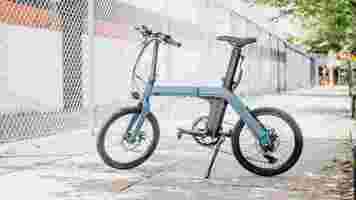
Unfortunately, the folding design often means you get a wimpy battery, a heavy and ugly frame, or a high price tag. The Fiido D11 manages to overcome several folding bike caveats while maintaining a price of just $999.
The D11 launched as an Indiegogo campaign last year and marked Fiido‘s entrance into the US market. As you’ve surely noticed by now, the D11 has a rather unusual design. Unlike most ebikes, which hide the battery in the frame or mount it awkwardly elsewhere, the D11 stuffs the battery into the chunky seatpost. While it’s not for everyone, you’ll likely get a lot of comments while riding it; I think it’s a pretty cool-looking bike, and it certainly stands out.
The seatpost battery has the benefit of allowing Fiido to use a larger battery than you typically find in the category, at 418 Wh (most folding ebikes in this price range have a roughly 300Wh battery), while still keeping the bike relatively lightweight at about 39 pounds, battery included. Anything under 40 pounds is basically featherweight for an ebike.
Fiido claims a maximum range of 100 km (62 mi), and based on my usage I’d estimate real-world range to be closer to 35-50 miles, depending on your assist level. That’s still really quite good for this category product, and more than enough for most riders. And if the battery does run out, the bike is still very much pedal-able thanks to the weight savings (NYC’s rideshare Citibikes weigh ~45 lbs, for reference) and a 7-gear drivetrain.
It’s worth noting now that this isn’t a bike built for crazy speed and torque — the D11 is limited to 25 km/h and uses a 250W, 35 Nm rear hub motor. Even among similarly spec’d motors, it’s on the ‘gentler’ side; the 250W motor on my (much more expensive) Brompton Electric feels noticeably more zippy. Still, it managed to get my larger self up some fairly steep hills, even if you’ll need to put in some work to maintain a good pace.
While I prefer pedal ebikes and generally do not care about throttles, having the option on the D11 was nice. It’s handy when starting from a dead stop, especially as the D11 uses a cadence sensor rather than a fancier torque sensor, so it takes about a half-turn for the assist to kick in. And if you don’t want to pedal at all, if you hold down the throttle for five seconds, it’ll enter ‘moped mode,’ which is basically cruise control.
Kudos to Fiido for including an actually-decent headlight and taillight which are directly wired to the power system (the taillight is actually in the seatpost); I’ve more expensive bikes with worse lighting. The display on the other hand is about as basic as they come, but it gets the job done. And though I’d rather have a proper bell (hint: get a Spurcycle), the built-in horn is certainly loud enough.
The bike uses mechanical disk brakes, which aren’t as fancy as the hydraulic disc brakes on many ebikes, but they’re easier to maintain and are still superior to most rim brakes you’d find on most regular bikes. Considering the motor’s speed limitation, there isn’t a great need for more stopping power.
There’s a lot to like with the D11, but it’s not perfect. Some general notes to be aware of:
The mega chunkster seatpost means you can’t replace it with a bump-softening suspension seatpost. There are suspended saddles you can buy, but the design limits your options in this regard.
The chunky seatpost also means you can’t use seatpost accessories like the Burley Travoy cargo trailer or a seatpost-mounted rack.
Find a rack that fits appears to be somewhat tricky; I wished Fiido offered something official. There are some solutions in this customer’s YouTube video though.
The bike does come with fenders, but they’re a little finnicky to install.
The included grips are absolutely horrendous and are to be replaced immediately.
The taillight is on while the bike is charging, and again, it’s quite bright, so it can be annoying in dark spaces.
Though the bike looks very cool from a distance and it feels very sturdy, the welds do look a little less polished up close.
The frame lacks closed loops, which makes locking up feel less secure. If you try to use a U-lock around the seat stays and rear wheel, for instance, a thief could remove the wheel, cut the motor cable, and be off with the bike. That’d be really dumb, since the motor is worth a good chunk of money, but it’s not an unrealistic scenario. You could set up a . I’d suggest using something like the Pinheads system to make it more difficult for thieves to remove vulnerable components.
While the bike can be rolled when folded, there isn’t an included strap or magnet to hold the two sides together.
At 6′ tall, I found the bike slightly small and wished it had an adjustable-height stem, but it would be easy enough to get riser handlebars (and there’s plenty of clearance in the folding mechanism.
It’s also worth noting that Fiido is actually planning to announce a fancier ebike akin to the D11 named the Fiido X . This model incorporates a torque sensor, a sleeker seatpost mechanism, a keyless security system, and an overall sleeker design.
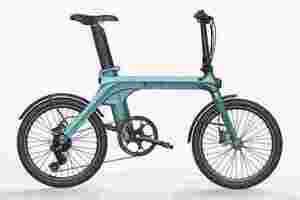

Those caveats aside, one of my favorite things about the D11 has to do with Fiido itself. While I can’t speak to the company’s customer service, especially as it’s only been in the US market for about a year, I have to commend them for being one of the very few ebike companies that actually stocks and sells complete replacement parts. The warranty may only be one year, but as far as I can tell, Fiido almost every component for repairing its ebikes online.
The pedals, the folding mechanism, the derailleur, the display, the rear wheel and motor assembly, the controller, the torque sensor, the seatpost/battery, and more are all available online . Heck, you can even just buy the bike’s bare frame if you need to for whatever reason.
These parts ship from China rather than Fiido’s US and Europe warehouses, but the fact that they’re available at all (and not outlandishly priced) is remarkable. It makes me feel like Fiido is planning for the long term rather than just making ‘disposable’ ebikes. It’s also appreciated as most bike shops will not have the equipment necessary to repair an ebike (and many will flat out refuse to try).
The Fiido D11 is an easy recommendation for anyone looking for a lightweight, stylish, and foldable ebike with solid range. There’s not much else quite else like it on the market, so as long as you’re aware of a few caveats, it’s worth a good look — especially for $999.